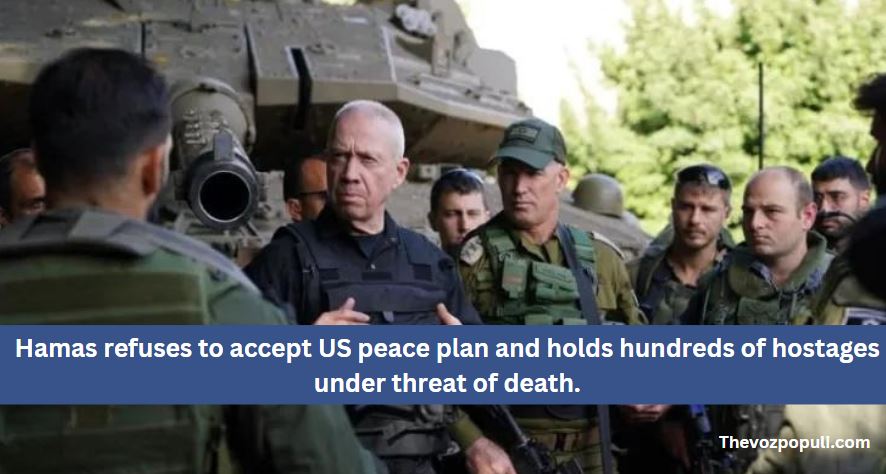Hamas, the Palestinian militant group, has recently rejected the latest U.S. peace plan aimed at resolving the Israeli-Palestinian conflict. This refusal comes amidst an escalating crisis, as Hamas has reportedly taken hundreds of hostages and issued severe threats of death against them. The group’s stance and actions have further intensified the already volatile situation, raising significant concerns about the prospects for peace and the safety of those held captive.
On Tuesday, Hamas dismissed the latest U.S. ceasefire proposal for Gaza as a “coup,” arguing that it fails to address two of their primary demands: a comprehensive ceasefire and the withdrawal of Israeli forces from the enclave. According to Hamas, the proposal undermines agreements previously reached on July 2 and does not align with U.S. President Joe Biden’s statements or UN Security Council Resolution 2735. The group criticized President Biden’s comments as “misleading” and “biased,” asserting that they remain committed to ending the conflict as agreed with mediators.
The U.S. had presented various ceasefire drafts in June and July, which Hamas initially accepted. However, Israeli Prime Minister Benjamin Netanyahu has since introduced new conditions, such as Israeli control over crucial border areas and military routes. Recent media leaks suggest the proposal only envisions a permanent ceasefire in a second phase, contingent on future negotiations, and permits Israel to resume military operations if Hamas does not meet its demands. Additionally, the proposal does not include a complete withdrawal of Israeli troops from Gaza, further fueling Hamas’ rejection.
On Monday, U.S. Secretary of State Antony Blinken announced from Tel Aviv that Israeli Prime Minister Benjamin Netanyahu had agreed to the latest ceasefire proposal. Blinken emphasized the need for Hamas to accept the deal as well, following a “very constructive meeting” with Netanyahu. The Israeli leader confirmed Israel’s acceptance of the U.S. transition proposal discussed last week in Doha. Blinken urged Hamas to respond positively to the proposal.
Read more: Panic Psoe Elections Autonomies
After the meeting, Netanyahu focused on efforts to secure the release of as many hostages as possible in the initial phase of the agreement. He also met with the families of the hostages. He reiterated that Israel would not agree to withdraw from the strategically important Philadelphia and Netzarim corridors, as reported by Hebrew media.
The conflict has already resulted in over 40,100 Palestinian casualties and nearly two million displaced individuals in Gaza. Currently, 105 hostages remain in Gaza, with at least 34 confirmed dead.
Frequently Asked Questions
What are Hamas’ main objections to the U.S. peace plan?
Hamas objects to the U.S. peace plan primarily because it does not include two key demands: a comprehensive ceasefire in Gaza and the withdrawal of Israeli forces from the enclave. Hamas believes the proposal undermines previous agreements and is biased towards Israeli conditions.
What does the U.S. peace plan entail?
The U.S. peace plan includes a transition proposal that Israel has accepted, which involves steps toward a ceasefire but does not immediately address all of Hamas’ demands. The plan also stipulates conditions for future negotiations, including the possibility of a permanent ceasefire.
Why has Hamas refused to accept the peace plan?
Hamas has refused to accept the plan because they believe it does not meet their demands for a complete ceasefire and total withdrawal of Israeli troops from Gaza. They also argue that the plan contradicts previous agreements and is influenced by new conditions set by Israeli Prime Minister Benjamin Netanyahu.
What is the current situation with the hostages held by Hamas?
Hamas is holding approximately 105 hostages, with at least 34 confirmed dead. The group has issued threats against the remaining hostages, which has heightened international concern and pressure on all parties involved.
What has been the impact of the ongoing conflict on the civilian population in Gaza?
The conflict has resulted in over 40,100 Palestinian deaths and displaced nearly two million people from their homes. The humanitarian situation in Gaza is dire, with many individuals lacking access to necessities and safe shelter.
How has the U.S. government responded to the situation?
The U.S. government, represented by Secretary of State Antony Blinken, has urged Hamas to accept the peace plan and emphasized that Israel has agreed to the proposed terms. The U.S. is actively involved in diplomatic efforts to resolve the conflict and address the hostage situation.
What are the next steps in the peace process?
The following steps depend on Hamas’ response to the U.S. peace plan. If Hamas accepts the proposal, the plan includes a phased approach to ceasefire and further negotiations. If Hamas rejects it, the situation may continue to escalate, affecting both the peace process and the humanitarian crisis.
Conclusion
Hamas’ refusal to accept the latest U.S. peace plan and their ongoing hostage crisis underscores the complexities and challenges in resolving the Israeli-Palestinian conflict. The rejection of the plan, which Hamas argues fails to meet their key demands, and their threats against hostages exacerbate the humanitarian crisis in Gaza and complicate international diplomatic efforts. The situation remains fluid, with significant implications for both regional stability and global diplomatic relations. Moving forward, the resolution of these issues will require careful negotiation and substantial compromise from all parties involved.



